What The API Says & What It Shouldn’t – The Hidden Dangers of Excess Data
- April 07
- 6 min

An API (Application Programming Interface) serves as a fundamental communication mechanism that enables different software systems to interact with each other. In system integration, APIs act as bridges that allow disparate applications to exchange data, share functionalities, and work together seamlessly—often in real-time.
At its core, an API defines a set of rules, protocols, and tools that specify how software components should interact. It creates a standardized interface that abstracts the underlying complexity of systems, making integration significantly more manageable and efficient.
Technically, an API is a contract that specifies how one piece of software can communicate with another. This contract includes:
APIs expose specific functionalities while hiding internal implementation details. This encapsulation is crucial as it allows systems to evolve independently without breaking existing integrations, as long as the API contract remains stable.
Several architectural styles dominate API design, each with distinct characteristics. REST (Representational State Transfer) APIs use standard HTTP methods and stateless operations, typically transferring data in JSON format—making them today’s most widely used approach. SOAP (Simple Object Access Protocol) offers a more rigid protocol with XML formatting and built-in security features. GraphQL allows clients to request precisely the data they need, eliminating over-fetching problems. Meanwhile, gRPC leverages HTTP/2 and Protocol Buffers for high-performance, low-latency communication between services.
System integration involves connecting different applications, databases, and services to function as a unified whole. APIs make this possible by providing several key capabilities:
Standardized communication: Instead of building custom point-to-point connections between each system (which quickly becomes a maintenance nightmare), APIs provide a standardized way for systems to talk to each other regardless of their underlying technologies or programming languages.
Decoupled architecture: APIs allow systems to remain independent while still working together. This loose coupling means changes to one system don’t necessarily require changes to all connected systems.
Data transformation: APIs can handle the translation of data formats between systems, ensuring that information flows correctly even when systems use different data structures.
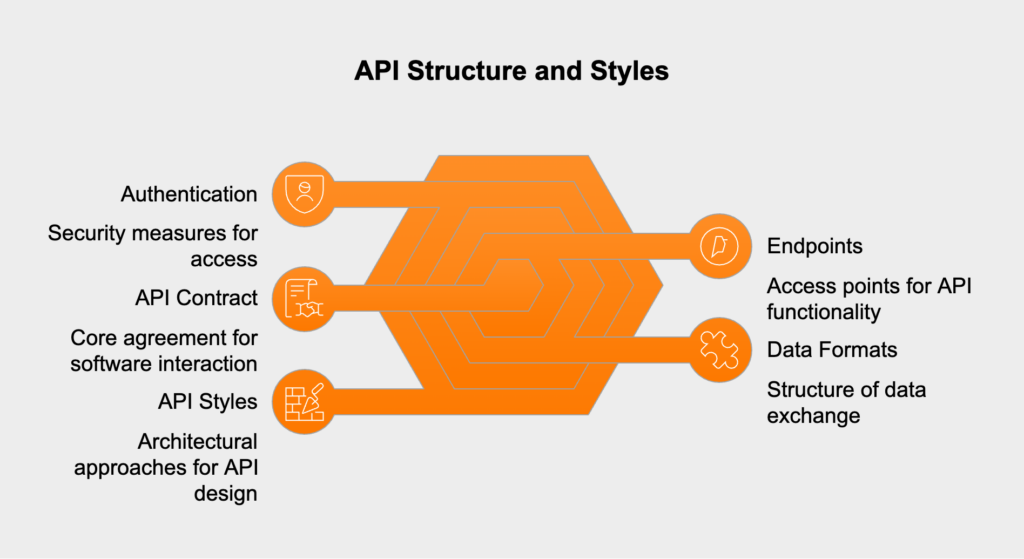
Consider an e-commerce platform processing payments: it doesn’t need to understand complex banking protocols. It simply sends transaction data to a payment gateway’s API, which handles all the complicated parts and returns a simple success or failure response. The beauty lies in this simplicity—each system does what it does best.
Different integration scenarios call for different types of APIs:
Internal APIs (private APIs) operate within an organization to connect internal systems and services. They typically have less stringent security requirements but must support the specific needs of the organization’s workflows. Meanwhile, external APIs (public or partner APIs) enable integration with third-party systems outside the organization. These require more robust security, documentation, and stability as they’re used by external developers or partners.
Web APIs operate over HTTP/HTTPS and are accessible from any system with internet connectivity. They’re platform-independent and widely used for cloud-based integrations. In contrast, native APIs are specific to operating systems or platforms (like Windows API or iOS API). They provide direct access to system-level functions and are used when deeper integration with the operating system is required.
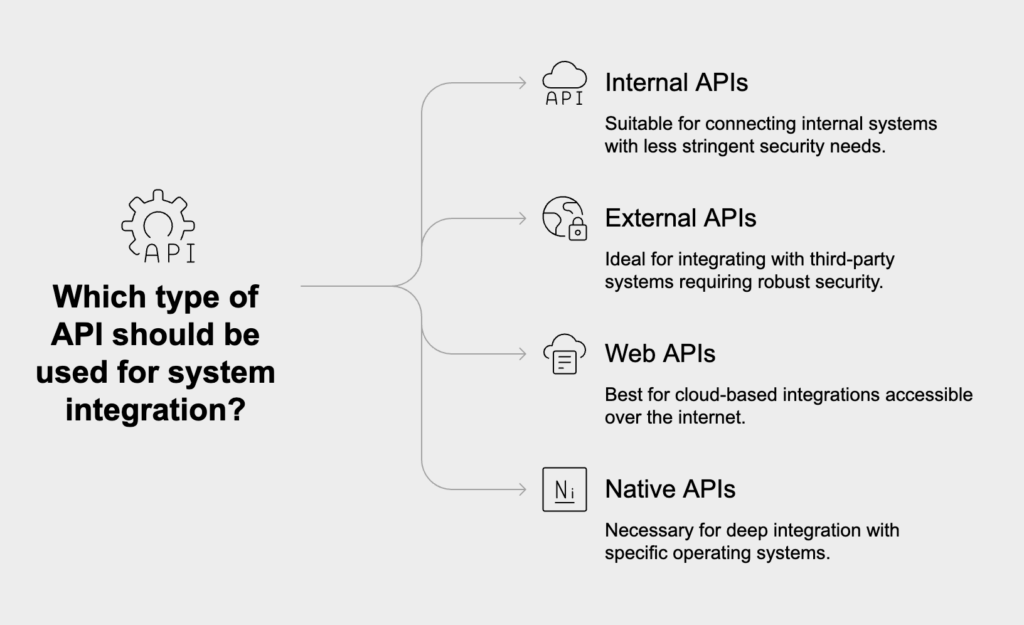
APIs represent just one approach to system integration. Understanding how they compare to other methods helps clarify their specific role:
While direct database connections allow systems to read and write data directly to a database, they create tight coupling and expose internal data structures. APIs provide a more controlled, secure interface that hides implementation details and enforces business rules during data exchange. For instance, rather than allowing a third-party application direct access to your customer database (exposing schema details and potentially all customer data), an API can provide specific endpoints that return only the necessary information while applying appropriate security checks.
Traditional file-based integration involves systems exchanging data through files (CSV, XML, etc.) placed in shared locations. While straightforward, this approach typically operates in batch mode rather than real-time. APIs enable immediate, on-demand data exchange, making them suitable for scenarios requiring real-time information. They also provide better error handling and transaction management compared to file-based approaches.
Several patterns have emerged for effectively using APIs in enterprise integration:
An API gateway serves as a single entry point for all clients, routing requests to the appropriate backend services. It handles cross-cutting concerns like:
This pattern simplifies client interactions with complex backend systems by providing a unified interface while handling many common integration challenges centrally.
In microservices architectures, each service typically exposes its own API. These services communicate with each other through their APIs to fulfill business processes that span multiple domains. Take an order processing workflow—it might involve calls to inventory APIs, customer APIs, payment APIs, and shipping APIs. Each is managed by different teams but works together through well-defined interfaces.
Event-driven APIs use a publish-subscribe model where systems emit events when significant changes occur, and other systems subscribe to events they’re interested in. This approach reduces coupling between systems and enables real-time reactions to business events. When a new order is placed, for example, an event is published that triggers multiple downstream processes (inventory updates, shipping preparation, etc.) without the ordering system needing to know about all these dependencies.
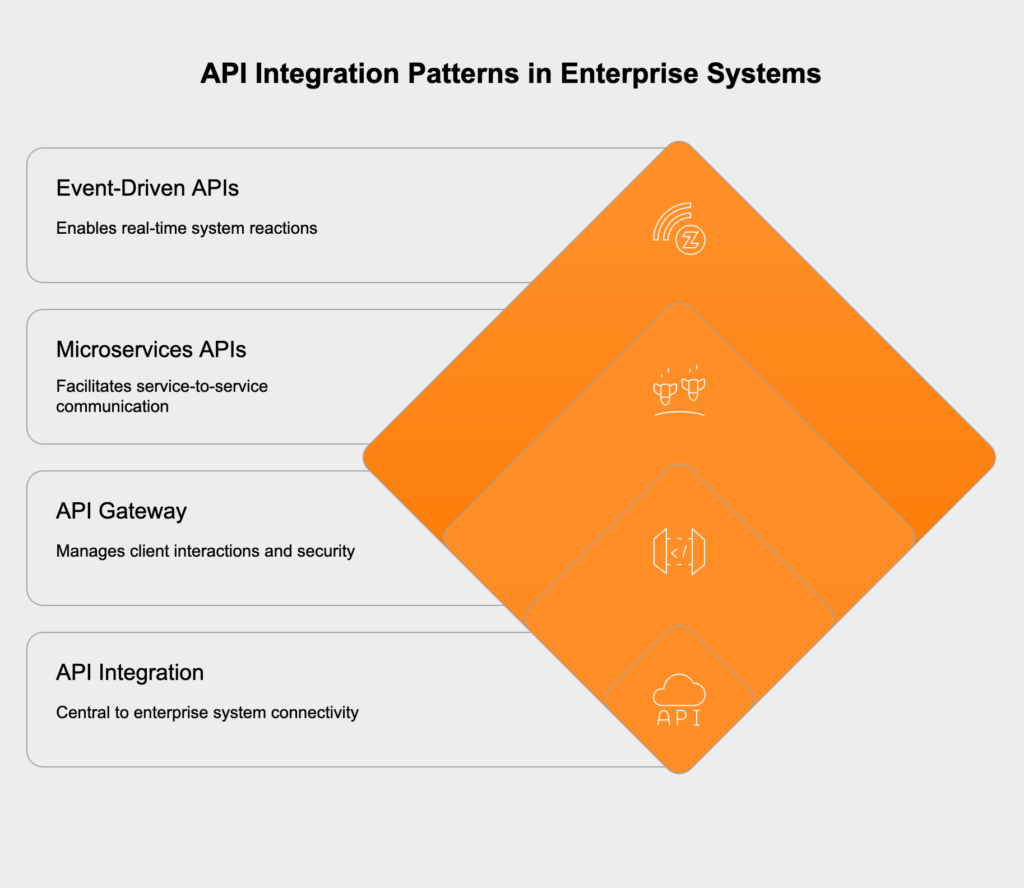
Effective API management is crucial for successful system integration, especially as the number of APIs grows within an organization.
API management encompasses:
Organizations typically implement API management platforms that provide tools for the entire API lifecycle, from design and testing to deployment and retirement. These platforms help ensure that APIs remain secure, performant, and aligned with business needs.
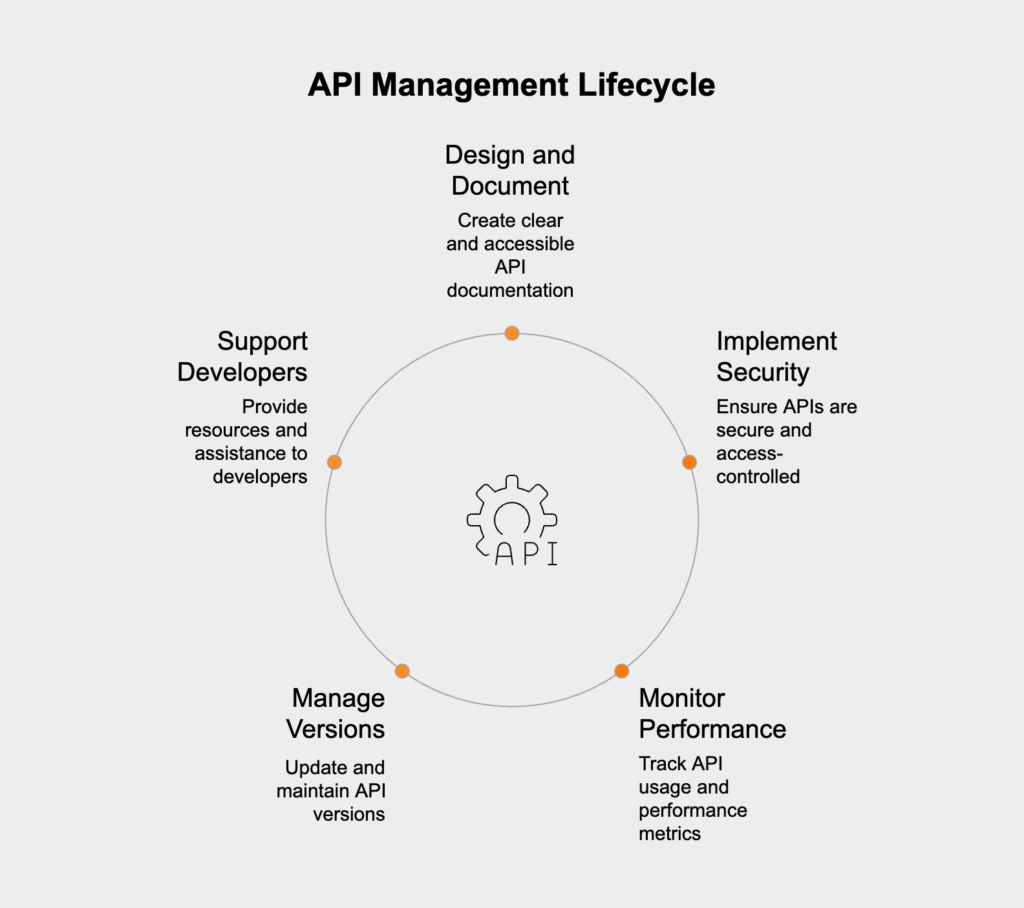
APIs can become significant security vulnerabilities if not properly protected. Key security considerations include:
APIs need robust mechanisms to verify who is making requests (authentication) and what they’re allowed to do (authorization). Common approaches include API keys for simple identification, OAuth 2.0 for delegated authorization, JWT (JSON Web Tokens) for secure information exchange, and OpenID Connect for authentication. Proper implementation of these standards helps prevent unauthorized access to sensitive data and functionality.
APIs often transmit sensitive information that requires protection both in transit and at rest:
Additionally, APIs should implement rate limiting to prevent abuse and denial-of-service attacks that could disrupt integration flows.
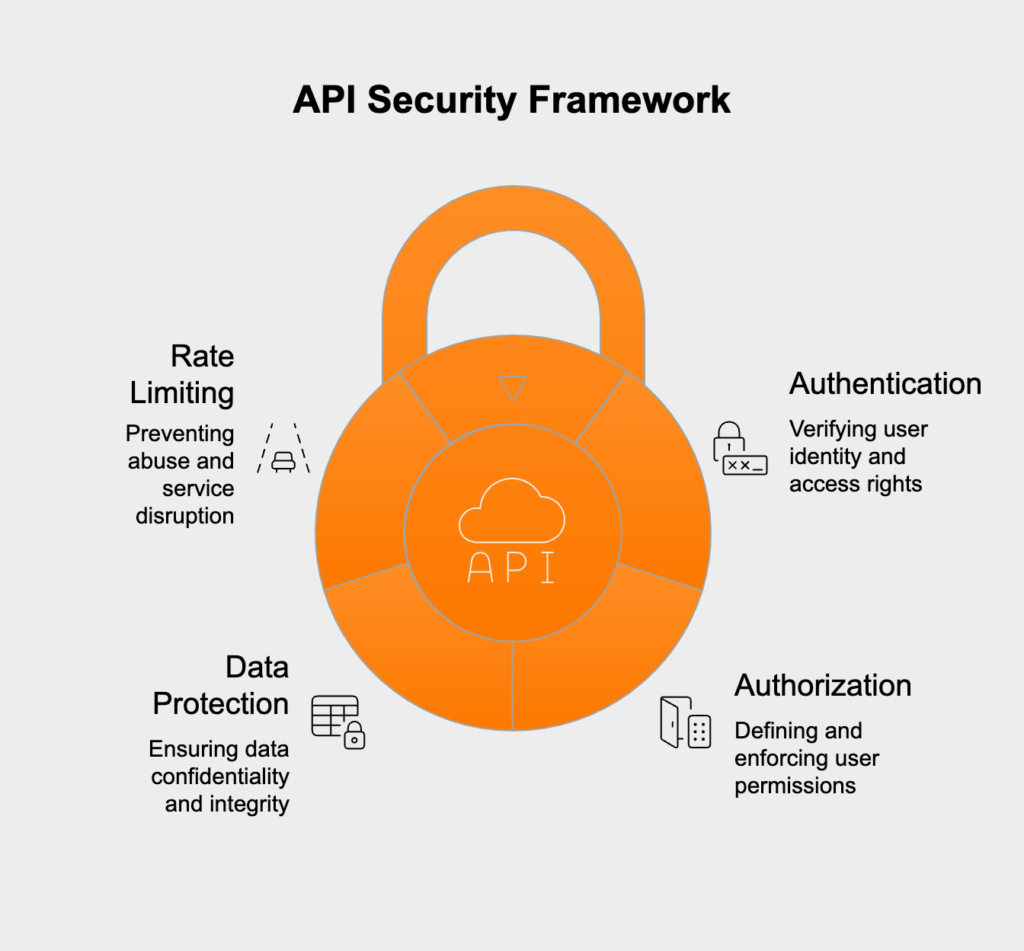
Despite their benefits, APIs present several challenges in system integration scenarios:
As systems evolve, APIs need to change while maintaining compatibility with existing integrations. This requires careful version management strategies. Teams must use semantic versioning to communicate the nature of changes, maintain backward compatibility when possible, support multiple API versions during transition periods, and establish clear deprecation policies and timelines. Without proper version management, API changes can break integrations and disrupt business processes.
APIs introduce network overhead and can become bottlenecks in high-volume integration scenarios. Addressing these challenges requires efficient API design (minimizing calls and payload sizes), smart caching strategies to reduce redundant requests, asynchronous processing for non-critical operations, and horizontal scaling of API infrastructure. Performance monitoring is essential to identify and address bottlenecks before they impact business operations.
Several categories of tools support API-based integration:
iPaaS (Integration Platform as a Service) solutions provide cloud-based platforms for building, deploying, and managing integrations. They typically include pre-built connectors for common applications and services, visual integration designers, data mapping and transformation tools, and monitoring and alerting capabilities. Examples include MuleSoft, Dell Boomi, and Informatica Cloud. These platforms reduce the complexity of integration development and maintenance.
Specialized tools help developers create, document, and test APIs. Swagger/OpenAPI has become the standard for API specification and documentation, while Postman simplifies API testing and collaboration. SoapUI handles functional and performance testing, and API gateways like Kong, Apigee, or AWS API Gateway manage API traffic. These tools improve API quality and developer productivity, leading to more reliable integrations.
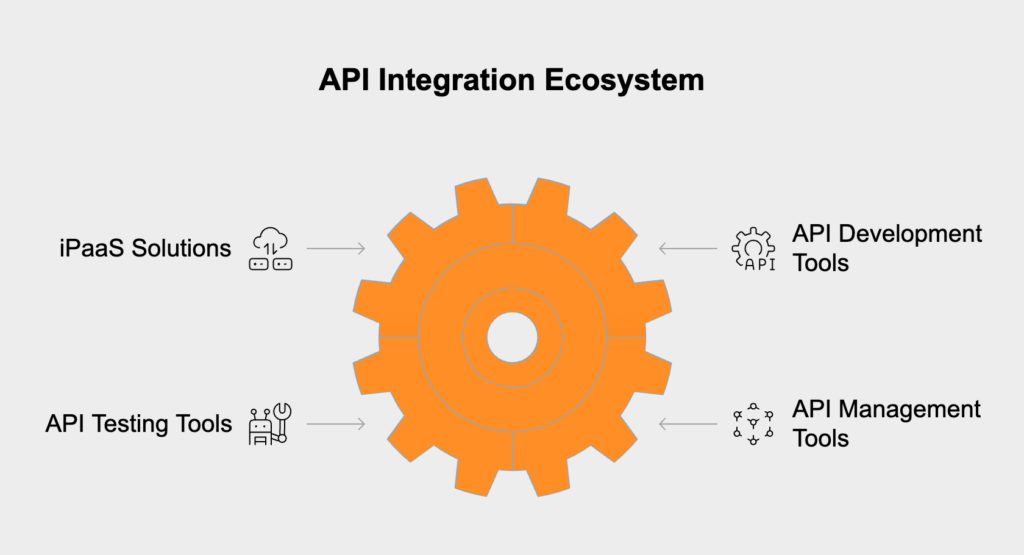
API-based integration continues to evolve with several emerging trends:
API-first design approaches are becoming standard, where APIs are designed before implementation begins, ensuring they meet integration needs from the start.
Event-driven architectures are growing in popularity, enabling more responsive and decoupled systems through asynchronous communication patterns.
GraphQL adoption is increasing for scenarios requiring flexible data retrieval, reducing the need for multiple API calls to assemble complex data views.
Serverless functions are being combined with APIs to create lightweight, scalable integration points that respond to events and API calls without maintaining dedicated infrastructure.
AI-enhanced APIs are emerging that incorporate machine learning capabilities, enabling more intelligent data processing and decision-making within integration flows.
As organizations continue their digital transformation journeys, APIs will remain central to their integration strategies, enabling the agility and connectivity needed in modern business environments.
